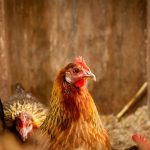Chickens are social creatures that thrive in structured environments. They possess a natural instinct to peck and scratch at the ground while foraging for food. This behavior extends to their drinking habits, with chickens preferring easily accessible, ground-level water sources.
Their attraction to shiny objects means that reflective surfaces in watering systems can encourage increased water consumption. As creatures of habit, chickens can become stressed by sudden environmental changes. Therefore, any modifications to their watering system should be introduced gradually to minimize stress and confusion.
Understanding these behavioral traits is essential when selecting and implementing a watering system for chickens, as it ensures the system aligns with their natural instincts and preferences. Chickens are known for their messy drinking habits, often spilling water while pecking and scratching around the watering area. This behavior can result in water waste and unsanitary coop conditions.
Recognizing these natural behaviors underscores the importance of choosing an appropriate watering system and implementing it correctly to maintain the health and well-being of the flock.
Table of Contents
- 1 Choosing the Right Watering System for Chickens
- 2 Placement of the Watering System
- 3 Using Anti-Spill Devices
- 4 Training Chickens to Drink Properly
- 5 Regular Maintenance of the Watering System
- 6 Troubleshooting Common Issues with Water Spillage
- 7 FAQs
- 7.1 What are some common reasons why chickens spill their water?
- 7.2 What are some strategies for preventing chickens from spilling their water?
- 7.3 Are there specific types of waterers that are less prone to spilling?
- 7.4 How often should I check and refill my chickens’ water to prevent spillage?
- 7.5 Are there any behavioral or environmental factors that can contribute to chickens spilling their water?
Key Takeaways
- Chickens are naturally curious and will investigate their surroundings, including their water source.
- The right watering system for chickens depends on factors such as flock size, climate, and available space.
- Proper placement of the watering system is crucial to ensure easy access for the chickens and to minimize spillage.
- Anti-spill devices can help reduce water wastage and keep the coop clean and dry.
- Training chickens to drink properly can be achieved through patience, consistency, and positive reinforcement.
Choosing the Right Watering System for Chickens
Gravity-Fed Waterers: Simple and Inexpensive
Gravity-fed waterers are simple and inexpensive, making them a popular choice for small flocks. These waterers consist of a container that holds the water and a base that allows the chickens to access it. While gravity-fed waterers are easy to set up and maintain, they can be prone to spillage and contamination if not positioned correctly.
Nipple Waterers: Minimizing Spillage and Waste
Nipple waterers, on the other hand, are designed to minimize spillage and keep the water clean. These waterers consist of a series of valves or nipples that release water when pecked by the chickens. Nipple waterers are a great option for larger flocks and can help reduce water waste and maintain a cleaner coop environment.
Automatic Waterers: Convenience and Reliability
Automatic waterers are another option for chicken owners looking for a low-maintenance watering system. These systems are connected to a water source and use a float valve to maintain a consistent water level. While automatic waterers require more initial investment and installation, they can provide a reliable and convenient water supply for chickens.
Choosing the Right Watering System for Your Flock
Choosing the right watering system for your chickens will depend on factors such as flock size, budget, and maintenance preferences. It’s important to consider the specific needs of your flock and choose a system that will provide clean, accessible water while minimizing spillage and waste.
Placement of the Watering System

The placement of the watering system is crucial for ensuring that chickens have easy access to clean water while minimizing spillage and contamination. When positioning the watering system, it’s important to consider factors such as flock size, coop layout, and natural behaviors of the chickens. Ideally, the watering system should be placed at ground level to accommodate the natural drinking habits of chickens.
This will make it easier for the birds to access the water and reduce the risk of spillage. Additionally, placing the watering system in a shaded area can help keep the water cool and prevent algae growth, ensuring that the water remains clean and fresh for the chickens. It’s also important to consider the number of watering stations needed based on the size of the flock.
Having multiple watering stations can help prevent overcrowding and competition among the chickens, ensuring that all birds have equal access to water. Additionally, placing the watering stations in different areas of the coop can encourage chickens to move around and forage, promoting healthy exercise and natural behaviors. When positioning the watering system, it’s important to consider the layout of the coop and any potential obstacles or hazards that could lead to spillage or contamination.
Ensuring that the watering system is secure and stable will help prevent accidental spills and keep the coop environment clean and hygienic for the chickens.
Using Anti-Spill Devices
To minimize spillage and waste, using anti-spill devices in conjunction with the watering system can be highly beneficial for chicken owners. Anti-spill devices are designed to prevent water from being wasted or contaminated by keeping it contained within the watering system. One common anti-spill device is a drip cup attachment that can be added to nipple waterers.
These cups catch any excess water that drips from the nipples, preventing it from pooling on the ground and creating a mess. Drip cups are easy to install and can help keep the area around the watering system clean and dry. Another anti-spill device that can be used with gravity-fed or automatic waterers is a drip tray or catchment basin.
These trays are placed underneath the watering system to catch any spilled or leaked water, preventing it from soaking into the ground or creating unsanitary conditions in the coop. Drip trays are easy to clean and can help maintain a cleaner environment for the chickens. In addition to using anti-spill devices, regularly inspecting and maintaining the watering system can help prevent spills and leaks.
Checking for any worn or damaged parts, such as seals or valves, can help ensure that the system remains watertight and functional. By using anti-spill devices and conducting regular maintenance, chicken owners can minimize water waste and maintain a cleaner coop environment for their flock.
Training Chickens to Drink Properly
Training chickens to drink properly from the watering system is an important step in ensuring that they have access to clean water while minimizing spillage and waste. Chickens may need some time to adjust to a new watering system, especially if they are used to a different type of waterer or location. One effective way to train chickens to use a new watering system is by gradually introducing it alongside their existing water source.
This can help familiarize the birds with the new system without causing confusion or stress. Placing treats near the new watering system can also encourage chickens to explore and drink from it, helping them become accustomed to its presence. Additionally, providing positive reinforcement when chickens use the new watering system can help reinforce this behavior.
This can be done by offering treats or praise when chickens drink from the new system, encouraging them to continue using it in the future. It’s important to be patient when training chickens to use a new watering system, as some birds may take longer than others to adjust. By taking a gradual approach and providing positive reinforcement, chicken owners can help ensure that their flock drinks properly from the new system while minimizing spillage and waste.
Regular Maintenance of the Watering System

Cleaning the Watering System
One important aspect of maintenance is cleaning the watering system regularly to prevent algae growth, bacterial contamination, and mineral buildup. This can be done by emptying and scrubbing the containers, replacing any dirty or moldy parts, and ensuring that all components are free from debris or blockages.
Inspecting the Watering System
In addition to cleaning, inspecting the watering system for any signs of wear or damage is crucial for preventing leaks and spills. Checking for loose fittings, cracked seals, or worn valves can help identify potential issues before they escalate into larger problems.
Monitoring Water Levels and Refilling
It’s also important to monitor the water level in the containers regularly and refill them as needed to ensure that chickens always have access to clean water. This is especially important during hot weather when chickens may drink more frequently to stay hydrated. By conducting regular maintenance of the watering system, chicken owners can ensure that their flock has access to clean water while minimizing spillage and waste. This will help promote a healthier environment for the chickens and reduce the risk of water-related health issues.
Troubleshooting Common Issues with Water Spillage
Despite careful planning and maintenance, chicken owners may still encounter common issues with water spillage in their coop. Identifying these issues and implementing solutions can help minimize waste and maintain a cleaner environment for the flock. One common issue with water spillage is overcrowding at the watering stations, which can lead to competition among the chickens and spills as they jostle for access.
Adding additional watering stations or increasing the size of existing ones can help alleviate overcrowding and reduce spillage. Another common issue is leaks or drips from nipple waterers, which can lead to wasted water and unsanitary conditions in the coop. Inspecting the nipples regularly for wear or damage and replacing any faulty ones can help prevent leaks and minimize spillage.
In some cases, environmental factors such as uneven ground or high humidity can contribute to water spillage in the coop. Leveling the ground around the watering stations or providing additional shade can help reduce spills caused by these factors. By troubleshooting common issues with water spillage and implementing effective solutions, chicken owners can minimize waste and maintain a cleaner environment for their flock.
This will help ensure that chickens have access to clean water while promoting their health and well-being.
If you’re looking for more tips on keeping chickens, you might be interested in an article on where to put your chicken coop. This article discusses the best location for your coop to ensure the health and safety of your chickens. Check it out here.
FAQs
What are some common reasons why chickens spill their water?
Some common reasons why chickens spill their water include pecking at the waterer, knocking it over while scratching, or simply being clumsy while drinking.
What are some strategies for preventing chickens from spilling their water?
Some strategies for preventing chickens from spilling their water include using a larger, heavier waterer, placing the waterer on a stable surface, or using a waterer with a cover or lid.
Are there specific types of waterers that are less prone to spilling?
Yes, there are specific types of waterers that are less prone to spilling, such as nipple waterers or waterers with a moat or barrier around the edge to prevent spillage.
How often should I check and refill my chickens’ water to prevent spillage?
It is recommended to check and refill your chickens’ water at least once a day to ensure they have an adequate supply and to prevent spillage from occurring.
Are there any behavioral or environmental factors that can contribute to chickens spilling their water?
Yes, factors such as overcrowding, boredom, or stress can contribute to chickens spilling their water. Providing a stimulating environment and ensuring adequate space can help reduce the likelihood of spillage.
Meet Walter, the feathered-friend fanatic of Florida! Nestled in the sunshine state, Walter struts through life with his feathered companions, clucking his way to happiness. With a coop that’s fancier than a five-star hotel, he’s the Don Juan of the chicken world. When he’s not teaching his hens to do the cha-cha, you’ll find him in a heated debate with his prized rooster, Sir Clucks-a-Lot. Walter’s poultry passion is no yolk; he’s the sunny-side-up guy you never knew you needed in your flock of friends!







